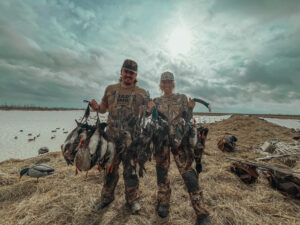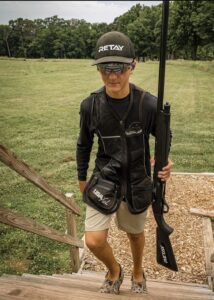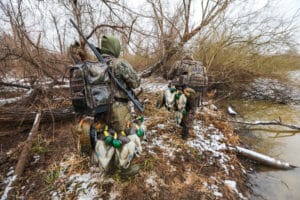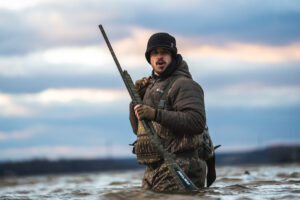
By: Justin Hunold

Over an IPA in his kitchen Craig said “You’ll meet Paul the Captain, Matt who lives fishing and has a ponytail and Brandon who is learning the game.” followed by, “I just fish with these guys here and there. They are Legit.” I will be an interloper in this game.
I have to explain, for Craig to call someone a legit angler means they are as real deal as ibuprofen is to pain relief, leave that aspirin at home kids. Craig is a US Coast Guard Licensed Captain, Federal Border Patrol Agent on Lake Ontario and, oh yeah, he owns 315 Guide Services. Needless to say he knows what it takes to be a Great Lakes Waterman and the people that make his cut are on a very short list.
In the late 1960’s the New York State Department of Environmental Conservation began to stock west coast transplanted salmon into Lake Ontario. This effort was to reinvigorate the fishery. During the years of market fishing and hunting the native Atlantic Salmon had been all but extirpated from the smallest of the Great Lakes. Chinook (King) and Coho Salmon were introduced, they are bred in the Salmon River Fish Hatchery. The facility is located just a touch towards Santa’s house, up the latitudinal lines in the town of Altmar New York.
There is a culture in upstate New York around these fish. These small towns north of Route 49 double, triple or even quintuple their populations during the salmon’s annual run up the local rivers to spawn. Pulaski and Oswego lead the way as far as name recognition goes, people come from around the world to invade and wade the rivers in those municipalities. Oswego County Holds ten world or state records for size of fish, both of these towns are in Oswego County. Mind you Pulaski High will graduate less than 100 seniors in any given year.
Math is constant. You wouldn’t think of it as an outsider, the math that matters is the dollars and cents on the line this particular day. You see, Team No Dil’Emma (Paul, Matt and Brandon) were leading the Fair Haven Challenge Tournament and running lines trying to capture the $25,500 prize for the largest Salmon of 2020 in the Fall LOC Derby. That is line one of the math, but the subsequent lines add up to those prizes if they are quantified correctly and the fish cooperate.

At 4:30 am we pulled into the parking lot of the docks. My Yeti had kept my coffee too hot to drink at this point. We walked ourselves and our gear down to the boat, Matt was already gassing the rig up. Matt is the glue of the team. Part of the math is how the members meld together, and in that department from my observation Matt is the JB Weld of the whole thing. After a few minutes Brandon and Paul showed up and they all began to prep.
Introductions were quick and the BSing started, but the tension of the morning was palpable. Most people in my position are the people who pay for fishing charters, treated as Royalty for a few hours on the boat. I wasn’t there for that, I was there to see what a high end prize focused team did throughout the day, and down to the second to catch fish. The detail is amazing. My goal was to take it all in, take some pictures and stay the hell out of the way. I didn’t want to cost them any fish, tackle, time or money.
The lines can’t hit the water until 6 am eastern time, and these are very strict rules. I had to enter the LOC derby just to ride along for fear of disqualification. We were under way and as the Twenty Eight foot vessel rounded the breakwall we went under full power. Matt was driving the boat, I was sitting across from him looking back on the organized chaos happening between the bounces of the waves under No Dil’Emma’s belly. Paul was rigging up Flashers, baits, and organizing all of the fishing gear.
Paul is the leader of the team and this is obvious, he was talking to Craig and Brandon and explaining what bait on which rods and two nets for every fish. What rods to get ready, and where they would be located, making the back of the boat look like an arachnid with too many legs on one side. You see on a normal fishing day Paul would be driving, Matt would be rigging and making the every second decisions and Brandon would be executing those orders. This is the way of things. Craig would be the lowest man on the totem pole, he isn’t a crew member but he knows enough to lend a hand.
Under these high stress payday possibilities Paul was making all the calls, rigging rods and taking charge of the back of the boat. Brandon was placing the rods on the racks of rod holders. We were in about 170 feet of water when the countdown started. Matt announced three minutes, the guys in the back still scrambling to take care of all of these rods that can sum up about five figures between rod, reel, line and actual fish catching tackle on the end. That is not to mention the Scotty electric down riggers, the eight to ten pound weights on those with a probe for the Fish Hawk trolling system attached just above the faceted fish shaped rigger weight. The probe alone is upwards of $300 retail, this system gives the actual depth of the baits attached to the down riggers along with trolling speed and temperature at the depth that the baits are at.
Two minutes, the planer boards were attached to the outriggers and sent out port and starboard a few hundred feet from the boat. These are used to spread the baits out so that the actual trolling footprint of the boat is much wider than the width of the gunnels. They are also useful for having baits at multiple depths in the water column
One minute, this is where plans are being stated out loud, Brandon has moved to the front of the boat, and inhabited the Captains seat at some point in the functional frantic moments. Matt is back snapping the lines into the down riggers, Paul is prepping more flasher/cutbait rigs, Craig is mirroring Matt’s efforts on the opposite side of the boat.
“All good, 6 O’clock!” Brandon exclaims.
The lines hit the water, the down rigger lines go down and out first, followed by the dipsy rods attached to the Planer Boards and then a rod loaded with 500 feet of copper line. All of these rods are at controlled and calculated depths. The math is astounding: the speed of the boat is controlled at the surface with the motors and Trolling Bags, which are essentially water filled parachutes on each side of the boat. That speed is displayed on the GPS on the console above the steering wheel, but that isn’t the speed of the baits which is the crucial number.
Speaking of the speed of the baits, that is displayed on the Fish Hawk which at that very moment wasn’t operating properly or at all for that matter. Paul walks up to look at it and then back to the aft fishing deck a few times frantically, then he hits the computer-like display like Fonzy and the jukebox and bingo bango it suddenly starts working. That was the biggest burst of luck this team would see all day.
The speed of the bait is a function of water pressure and drag at depth, speed of the boat, and the ever present current that you’d never expect on a lake of that size. So all things being equal the boat may be traveling at 3.5 miles per hour at the surface and the baits will be traveling at a slower speed say 2.7 at depth or sometimes with the current blowing up the butt of the boat the disparity between the numbers will be a lot closer. The fish will dictate the proper speed of the bait presentation. But that’s not the only math that they dictate. The depth they inhabit is dictated by the water temperature they live their best lives at, generally around 50 degrees fahrenheit. So, any given day the conditions above the surface can change their preferred depth by feet in the double digit range. Cold rain can bring them up in the column, so can wind, water turn over, sunlight and an assundry of other factors that I have no ideas on.
Now back to the rods with Dipsy Divers and Copper Line. They are depth control measures. Dipsy Divers are basically a flying saucer with line ties and unequal weight distribution. They dig into the water and because of the size and hydrodynamics the Dipsy takes the baits down to a predictable depth. Copper line will run the lures down via its denser than water nature, for every 100 feet of copper line the lure gains twenty feet of depth. We were putting out 500 feet. Is your head spinning yet?

All of this rigging took fifteen minutes. The calculus doesn’t stop there, Paul and Matt are checking the depth finder constantly, while Brandon is using compass headings to direct the boat over a certain depth of water. Yet with all this math the only thing that matters as far as numbers go is tangible pounds of salmon in the boat. And at 7:20 they had their first chance at making that number more than 0.
The rod that has the 500 feet of Copper loaded on it showed a strike, Matt grabbed it. If you watched any sort of big water fishing you’d expect Brandon to drop the boat into neutral and let Matt proceed to fight the very fresh, very big King Salmon with rod and reel alone. What I actually saw was amazing teamwork between driver and angler, using the boat to fight the fish in a way I hadn’t seen before. This plays multiple roles but one of my observations was that it allowed the crew to not have to clear any of the other lines out of the way for a long time, the boat was able to keep tension on the fish while Matt played him and finally it kept the rest of the baits moving so that the odds of a double were increased. The shuffle of two nets getting line up like two outfielders backing each other up happened about fifteen minute after the strike.
It was all business after Paul netted the fish, no big celebration, no hugs, no fist bumps or pumps. Back to work, Paul was working on making sure the right rods were in the right places with the right baits and Matt was double checking depths and drags, everything was checked and double checked. Nothing is left to chance, except the mood of the fish.
There is a misnomer in the non-angling world, that fishing is luck. I assure you most of fishing is not luck. I can tell you numerous stories about how it isn’t luck, until it is. This day out on the boat was littered with a bunch of unlucky strikes, balling baits up, pushing baits forward, not getting hooked when the fish would take a bait. None of these things are controlled by the angler. Those parts of fishing are luck.
“Lots of downtime.” Craig utters out loud
“Ain’t no uptime” Paul only half jokes.
“Temperature is down 20 feet from yesterday.” Paul states.
This literally means in the game of chasing temperature, the magic number of 45-50 degrees, that the water of that particular heat signature is twenty feet deeper than that temperature was yesterday, the water is warmer than the day before. See you’re always chasing numbers in this game, not the game species, but the numbers that lead to the optimum habitat.
Brandon goes to the back of the boat to relieve himself, and a fish hammers the rod that he is standing over. Brandon the consummate angler grabs the rod rather than zipping up. The fish is on and Brandon has a wide stance to keep his pants up rather than to provide good leverage on the fish. He took a camera in his face especially well considering the circumstances. Craig took the fishing rod from Brandon and proceeded to play the fish out. Matt landed the fish in the net with Paul standing behind with net number two as back up. Again when the chinook hit the floor at 9:56 there was no uproar, no hubbub. Just professionals looking for perfection of presentation as they got ready for the next one.
At 10:29 a rod goes off again, Paul grabs it and has the fish loaded, rod bent. Matt is at the helm at this point and is using the boat in conjunction with Paul’s reeling and leaning. The fight last for fifteen minutes, long enough for the other two guys to grab nets. Then it happens, the line gets slack and it is obvious to Paul that the fish which was once there isn’t any longer. Pure dejection.
“That one hurt big time,” He says to me.
Rough math is rough but, going into the weekend they were up about a fish worth on everyone in the Fair Haven Challenge. A team can weigh five fish, and they just lost a good one. Had that fish been in the boat the team would have more than likely been in the running, without it they wouldn’t bother weighing the other two.

The day rolled on like the waves on the surface, but unlike the waves the fishing was inconsistent. What’s funny is this group of guys that I really enjoyed hanging out with kept telling me that they wished they had shown me a better day of fishing. I had a great time, for a person who loves processes and unscripted stories, to watch a team perform like a play out in front of me was a pleasure in and of itself. I assured them that there was an amazing story on this day and that it doesn’t have to be littered with big fish. It can have more fish next time, but to tell the story of the fish isn’t the story of the Team, the men, the boat, the towns, the culture, or the math. All too often we as angler judge our days with a scale, ruler or phones full of grip and grins. I got to make some friends, hang out with my best friend and learn more math in an 8 hour run than I had in four years of public high school. I can’t thank Paul Powers, Matt Reibenfeld and Brandon Mirrer enough. We will write a big fish story next time.





